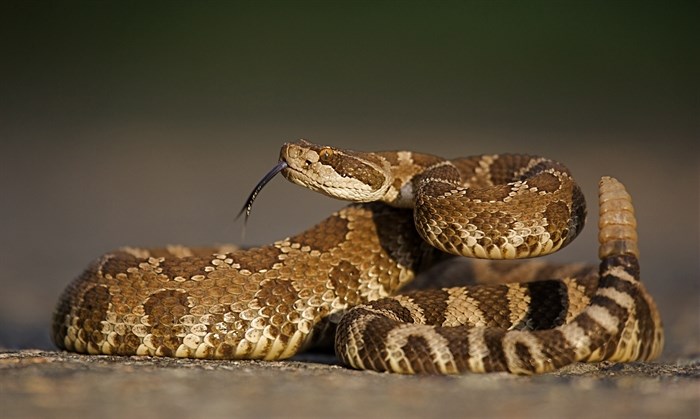
It's rattlesnake season in the B.C.'s interior and WildSafe B.C. provincial coordinator Frank Ritcey has some tips on how to keep you and your pets safe.
Image Credit: SUBMITTED/WildSafe B.C.
May 27, 2018 - 12:00 PM
It’s snake season in B.C's interior and to prepare yourself for an encounter with a northern Pacific rattlesnake, you should know where these snakes like to slither and what to do if you run into one.
With the weather getting warmer, you may begin to notice more of these rattlesnakes around the area. Although their bites can be poisonous, it’s usually not common for them to bite humans unless they are provoked.
“They only bite defensively so if you leave them alone, they will leave you alone,” says Frank Ritcey with WildSafe B.C.
The northern Pacific rattlesnake is the only rattlesnake found in British Columbia, according to WildSafe B.C. They can grow to be more than one metre in length and weigh about 900 grams. During the winter months, these snakes live in dens and only begin to emerge in areas where they might come into contact with humans in the late spring.
Ritcey says if you do meet a rattlesnake on a hike, back away cautiously and safely.
“As soon as you hear or see it, stop and check around you and behind you,” Ritcey says, adding that it's important to check everywhere to avoid stepping on a snake.
“Once you’ve backed away you’re probably safe, these snakes can only strike as far as 50 centimetres,” Ritcey says.
These rattlesnakes can be found in the interior's dry south-central valleys. Kamloops is the most northern range where the northern Pacific rattlesnake is found.
“(Areas) that have a good south facing exposure will have a good population of rattlesnakes there,” Ritcey says.
It's not guaranteed a snake will inject venom when it bites you, sometimes it can bite without injecting poison. Regardless, bites from these snakes are very serious and painful and require immediate attention from a doctor.
“Go straight to the hospital and try phoning ahead if you can so they are ready for you and can have the antivenin ready,” says the WildSafe B.C. provincial coordinator.
Depending on how big or small a person is, can also determine how serious a venomous bite is.
"The venom is going to work at a different rate, the smaller you are the more at risk you are going to be," Ritcey says.
A few things people should never do if they are bitten is trying to suck out the venom themselves or put ice on the bite.
"What you want to do is remove any tight-fitting clothing, because your body will swell in response to the bite," he says.
Ritcey says it's hard to put a time frame around how quickly a person should receive treatment when they are bitten, but the best thing to do is immediately go to the hospital after the bite happens. He says death by rattlesnake bites are rare.
"As long as you get to the hospital, there's a very good chance of survival," he says.
The WildSafe B.C. provincial coordinator also warns pet owners to keep dogs close to them when they're outdoors.
“Every year there are dogs killed by rattlesnakes,” Ritcey says. “Dogs are a real concern, so try to keep dogs on leashes and on trails.”
Ritcey says it’s also important to remember this type of rattlesnake is considered threatened and is protected under federal and provincial legislation. It’s illegal to harm, kill or capture the rattlesnake in B.C.
“It’s really important that we don’t lose any individuals,” he says, adding that if you find a snake on your property call bylaw enforcement or the Conservation Officer Service.
“Bylaw (officers) have had training on how to safely remove a snake and (people) can also phone the Conservation Officer Service 24/7 line,” he says.
Ritcey says people should avoid moving snakes themselves because it can be dangerous and also harm the snake.
“You can’t move a snake anywhere, it still has to be within home range to its den and it’s better to leave it up to the people that have been trained,” he says.
For more information, facts and safety tips on encounters with rattlesnakes visit the WildSafe B.C. website.
— This story was updated on Monday, May 28, 2018 at 10:04 a.m. to provide an accurate photo of the northern Pacific rattlesnake found in British Columbia.
To contact a reporter for this story, email Karen Edwards or call (250) 819-3723 or email the editor. You can also submit photos, videos or news tips to the newsroom and be entered to win a monthly prize draw.
We welcome your comments and opinions on our stories but play nice. We won't censor or delete comments unless they contain off-topic statements or links, unnecessary vulgarity, false facts, spam or obviously fake profiles. If you have any concerns about what you see in comments, email the editor in the link above.
News from © iNFOnews, 2018